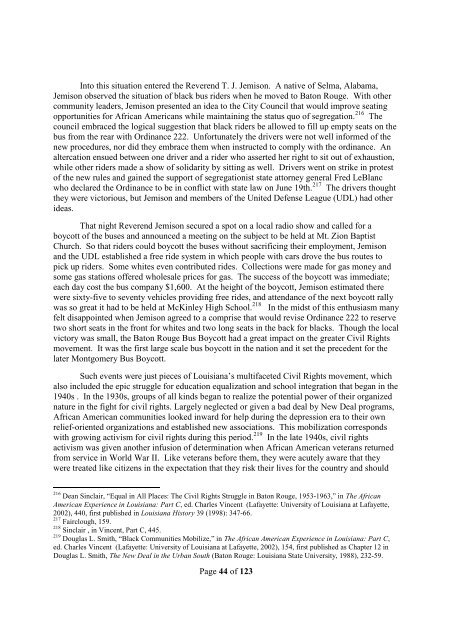The African American Experience in Louisiana
The_African_American_Experience_in_Louisiana
The_African_American_Experience_in_Louisiana
- No tags were found...
You also want an ePaper? Increase the reach of your titles
YUMPU automatically turns print PDFs into web optimized ePapers that Google loves.
Into this situation entered the Reverend T. J. Jemison. A native of Selma, Alabama,<br />
Jemison observed the situation of black bus riders when he moved to Baton Rouge. With other<br />
community leaders, Jemison presented an idea to the City Council that would improve seat<strong>in</strong>g<br />
opportunities for <strong>African</strong> <strong>American</strong>s while ma<strong>in</strong>ta<strong>in</strong><strong>in</strong>g the status quo of segregation. 216 <strong>The</strong><br />
council embraced the logical suggestion that black riders be allowed to fill up empty seats on the<br />
bus from the rear with Ord<strong>in</strong>ance 222. Unfortunately the drivers were not well <strong>in</strong>formed of the<br />
new procedures, nor did they embrace them when <strong>in</strong>structed to comply with the ord<strong>in</strong>ance. An<br />
altercation ensued between one driver and a rider who asserted her right to sit out of exhaustion,<br />
while other riders made a show of solidarity by sitt<strong>in</strong>g as well. Drivers went on strike <strong>in</strong> protest<br />
of the new rules and ga<strong>in</strong>ed the support of segregationist state attorney general Fred LeBlanc<br />
who declared the Ord<strong>in</strong>ance to be <strong>in</strong> conflict with state law on June 19th. 217 <strong>The</strong> drivers thought<br />
they were victorious, but Jemison and members of the United Defense League (UDL) had other<br />
ideas.<br />
That night Reverend Jemison secured a spot on a local radio show and called for a<br />
boycott of the buses and announced a meet<strong>in</strong>g on the subject to be held at Mt. Zion Baptist<br />
Church. So that riders could boycott the buses without sacrific<strong>in</strong>g their employment, Jemison<br />
and the UDL established a free ride system <strong>in</strong> which people with cars drove the bus routes to<br />
pick up riders. Some whites even contributed rides. Collections were made for gas money and<br />
some gas stations offered wholesale prices for gas. <strong>The</strong> success of the boycott was immediate;<br />
each day cost the bus company $1,600. At the height of the boycott, Jemison estimated there<br />
were sixty-five to seventy vehicles provid<strong>in</strong>g free rides, and attendance of the next boycott rally<br />
was so great it had to be held at McK<strong>in</strong>ley High School. 218 In the midst of this enthusiasm many<br />
felt disappo<strong>in</strong>ted when Jemison agreed to a comprise that would revise Ord<strong>in</strong>ance 222 to reserve<br />
two short seats <strong>in</strong> the front for whites and two long seats <strong>in</strong> the back for blacks. Though the local<br />
victory was small, the Baton Rouge Bus Boycott had a great impact on the greater Civil Rights<br />
movement. It was the first large scale bus boycott <strong>in</strong> the nation and it set the precedent for the<br />
later Montgomery Bus Boycott.<br />
Such events were just pieces of <strong>Louisiana</strong>’s multifaceted Civil Rights movement, which<br />
also <strong>in</strong>cluded the epic struggle for education equalization and school <strong>in</strong>tegration that began <strong>in</strong> the<br />
1940s . In the 1930s, groups of all k<strong>in</strong>ds began to realize the potential power of their organized<br />
nature <strong>in</strong> the fight for civil rights. Largely neglected or given a bad deal by New Deal programs,<br />
<strong>African</strong> <strong>American</strong> communities looked <strong>in</strong>ward for help dur<strong>in</strong>g the depression era to their own<br />
relief-oriented organizations and established new associations. This mobilization corresponds<br />
with grow<strong>in</strong>g activism for civil rights dur<strong>in</strong>g this period. 219 In the late 1940s, civil rights<br />
activism was given another <strong>in</strong>fusion of determ<strong>in</strong>ation when <strong>African</strong> <strong>American</strong> veterans returned<br />
from service <strong>in</strong> World War II. Like veterans before them, they were acutely aware that they<br />
were treated like citizens <strong>in</strong> the expectation that they risk their lives for the country and should<br />
216 Dean S<strong>in</strong>clair, “Equal <strong>in</strong> All Places: <strong>The</strong> Civil Rights Struggle <strong>in</strong> Baton Rouge, 1953-1963,” <strong>in</strong> <strong>The</strong> <strong>African</strong><br />
<strong>American</strong> <strong>Experience</strong> <strong>in</strong> <strong>Louisiana</strong>: Part C, ed. Charles V<strong>in</strong>cent (Lafayette: University of <strong>Louisiana</strong> at Lafayette,<br />
2002), 440, first published <strong>in</strong> <strong>Louisiana</strong> History 39 (1998): 347-66.<br />
217 Fairclough, 159.<br />
218 S<strong>in</strong>clair , <strong>in</strong> V<strong>in</strong>cent, Part C, 445.<br />
219 Douglas L. Smith, “Black Communities Mobilize,” <strong>in</strong> <strong>The</strong> <strong>African</strong> <strong>American</strong> <strong>Experience</strong> <strong>in</strong> <strong>Louisiana</strong>: Part C,<br />
ed. Charles V<strong>in</strong>cent (Lafayette: University of <strong>Louisiana</strong> at Lafayette, 2002), 154, first published as Chapter 12 <strong>in</strong><br />
Douglas L. Smith, <strong>The</strong> New Deal <strong>in</strong> the Urban South (Baton Rouge: <strong>Louisiana</strong> State University, 1988), 232-59.<br />
Page 44 of 123


